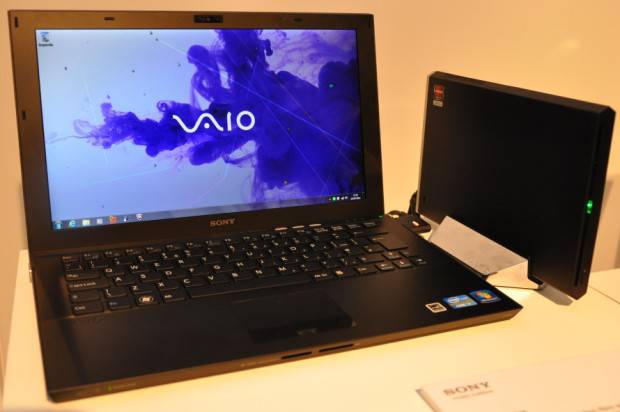Sony drops netbooks, shows tablets, adds Light Peak

Sony held its annual "Christmas in July" event in London yesterday to give the press a peek at forthcoming products, including all-in-one computers, cameras, TV sets, audio systems, and a new ultra-light, ultra-thin Vaio Z designed to out-feature all of Apple's MacBooks. Sony's two new tablets, the S1 and S2, showed up, albeit sealed in a glass case. However, netbooks were noticeable by their absence. It turns out that Sony won't be offering us any more Atom-powered netbooks, after the current models have sold out. Instead, it will bridge the gap between netbooks and its usual Intel-powered laptops with a new Vaio Y range that, unusually for Sony, uses AMD processors.
The Sony Vaio Y Series is billed as "a fully-featured PC", which separates it from netbooks, and as the "ultimate travel companion". It has an 11.6in widescreen with a resolution of 1,366 x 768 pixels, which is the same as a standard 13.3in portable but in a smaller form factor. It also has a good isolated keyboard. Unlike Sony's previous netbooks, however, it features a 1.6GHz dual-core AMD E-350 Fusion processor with 4GB of memory for about £430.
Sony is far from being the only company to try this. Asus has the Eee PC 1215B (with a 12.1in screen) with the same AMD processor, while HP's version is the Pavilion dm1z. The idea is to offer something that looks like competition for the Samsung Series 9 or Apple MacBook Air at less than half the price.
This is a tricky one. The AMD E-350 offers (very roughly) twice the performance of the usual netbook Atom chips, being more on a par with low voltage Intel Core 2 Duo chips such as the U7500 and SU2300 previously used in thin laptops. In my experience, these are fine for normal purposes, such as web browsing and using Microsoft Office on Windows 7. On the other hand, the AMD E-350's performance is not significantly different from a dual core Intel Atom D525 processor, so the real question is: "What went wrong with Intel's marketing and/or pricing that allowed AMD to nick a slice of its Atom market?"
Alternatively, rather than saying "Sony drops netbooks," we could redefine the netbook market. Instead of "it uses an Intel Atom processor", we could say: "it uses an Intel Atom or AMD Fusion processor". That sounds fair enough but could mislead consumers into thinking that AMD's chip is roughly equivalent to a single-core Intel Atom N270, N450 or N455, and that's not the case either.
Other Sony laptops on display included the Vaio F Series 3D, which shows 3D movies using the same active-shutter glasses as Sony's Bravia TV sets, and the Vaio C Series, which comes in a range of bright "lifestyle" colours. The new models with 15.5in screens have Blu-ray drives as standard.
Sony competes with Apple in the high price-bracket markets, so it naturally focuses on things like 3D and industry standards such as Blu-ray, DNLA, and USB 3.0 that Apple can't or won't fully support. Which naturally brings us to Sony's latest ultrathin laptop, in a tradition that goes back to the extraordinary Sony X505 Extreme unveiled in 2003….
The tiny carbon-fibre Vaio Z is a real screamer with a Core i7-2620M processor, 8GB of memory, one or two SSDs, and a 13.1in screen that shows 1600 x 900 pixels or, optionally, a full HD 1920 x 1080. It can also connect to a Power Media Dock (which includes a DVD or Blu-ray drive) via an optical cable. This is, in fact, an implementation of Intel's high-speed Light Peak done more in the way Intel originally intended. Unlike Apple's Thunderbolt, Sony's version uses a USB-compatible connector.
The Vaio Z makes the MacBook Air look like a toy, but if you have to ask the price, you can't afford it.
As for the Sony S1 and S2 tablets, these were officially announced in April and it's slightly surprising that, as far as I could see, there weren't any samples available for hands-on testing. However, the S1 is a thin Android tablet with a 9.1in screen, while the S2 is a "folder" with two 5.5in screens. Like a Nintendo DS, you could pop one in a purse or pocket. Both have 3G and Wi-Fi connectivity, and the Sony advantage is that they can be used as remote controls for Bravia TV sets, or to display things on their big screens.
I confess that the S2 has aroused my techno-lust, so I can but hope that in real-world use it turns out to be disappointing.
 The new Sony Vaio Z is smaller than it looks: it measures 210 x 16.65 x 330mm and weighs 1.18kg. (Photo: Jack Schofield)
The new Sony Vaio Z is smaller than it looks: it measures 210 x 16.65 x 330mm and weighs 1.18kg. (Photo: Jack Schofield)